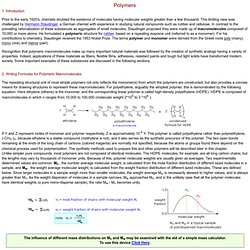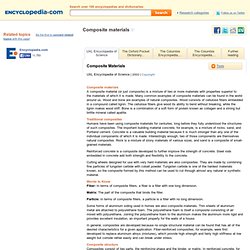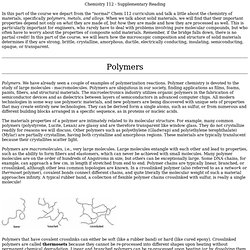

81219 unit g630 materials for a purpose unit recording sheet urs834. Concise Encyclopedia of Composite Materials. 18853.pdf. Polymers. Polymers 1.

Introduction Prior to the early 1920's, chemists doubted the existence of molecules having molecular weights greater than a few thousand. This limiting view was challenged by Hermann Staudinger, a German chemist with experience in studying natural compounds such as rubber and cellulose. In contrast to the prevailing rationalization of these substances as aggregates of small molecules, Staudinger proposed they were made up of macromolecules composed of 10,000 or more atoms. Recognition that polymeric macromolecules make up many important natural materials was followed by the creation of synthetic analogs having a variety of properties. 2. The repeating structural unit of most simple polymers not only reflects the monomer(s) from which the polymers are constructed, but also provides a concise means for drawing structures to represent these macromolecules. If Y and Z represent moles of monomer and polymer respectively, Z is approximately 10-5 Y. 3. 4. 1. 2. 3. 4.
Copolymers. Is glass liquid or solid? [Physics FAQ] - [Copyright] Updated PEG January 1997.

Original by Philip Gibbs October 1996, with thanks to many who contributed their knowledge and references. It is sometimes said that glass in very old churches is thicker at the bottom than at the top because glass is a liquid, and so over several centuries it has flowed towards the bottom. This is not true. AERO - Boeing 787 from the Ground Up. (Return to previous page) The Boeing 787 makes greater use of composite materials in its airframe and primary structure than any previous Boeing commercial airplane.

Undertaking the design process without preconceived ideas enabled Boeing engineers to specify the optimum material for specific applications throughout the airframe. The result is an airframe comprising nearly half carbon fiber reinforced plastic and other composites. This approach offers weight savings on average of 20 percent compared to more conventional aluminum designs. Selecting the optimum material for a specific application meant analyzing every area of the airframe to determine the best material, given the operating environment and loads that a component experiences over the life of the airframe. What are Composite Materials? (with pictures)
Composite materials Facts, information, pictures. A composite material (or just composite) is a mixture of two or more materials with properties superior to the materials of which it is made.

Many common examples of composite materials can be found in the world around us. Wood and bone are examples of natural composites. Wood consists of cellulose fibers embedded in a compound called lignin. The cellulose fibers give wood its ability to bend without breaking, while the lignin makes wood stiff. Bone is a combination of a soft form of protein known as collagen and a strong but brittle mineral called apatite. Traditional composites Humans have been using composite materials for centuries, long before they fully understood the structures of such composites. Reinforced concrete is a composite developed to further improve the strength of concrete.
Cutting wheels designed for use with very hard materials are also composites. Words to Know. Polymers. Chemistry 112 - Supplementary Reading In this part of the course we depart from the "normal" Chem 112 curriculum and talk a little about the chemistry of materials, specifically polymers, metals, and alloys.

When we talk about solid materials, we will find that their important properties depend not only on what they are made of, but how they are made and how they are processed as well. This is particularly important for engineers, who rarely have to deal with problems involving pure molecular compounds, but who often have to worry about the properties of composite solid materials. Remember, if the bridge falls down, there is no partial credit! In this part of the course, we will learn how the microscopic composition and structure of solid materials determines if they are strong, brittle, crystalline, amorphous, ductile, electrically conducting, insulating, semiconducting, opaque, or transparent.
Schoolphysics. The jam in a sponge pudding stays hotter for longer than the pudding around it Water is a very good coolant for use in engines Saucepans are made of materials with a low mass if possible It takes a long time to heat up enough water to have a hot bath Houses built with thick stone walls keep warm in winter and stay cool in summer People used to warm up heavy china teapots before putting the hot water and tea in them Storage radiators are used to retain heat energy for use later in the day You can put out a candle flame (temperature 800 oC) with moist fingers without pain but putting your hand into a bowl of boiling water (100 oC) would hurt a lot!

Electronic circuits are built with "heat sinks" When you run "hot" water into a basin it cools as soon as it touches the material of the basin Liquid sodium is used as a coolant in some nuclear reactors However, during the last century two men, Rumford and Joule, both proposed the idea that heat was related to energy. Example problems 1. 2. 3. GCSE Bitesize: Specific heat capacity. Specific Heat. Work_Hardening_and_Annealing_of_Copper.pdf.
168851 the ocr guide to testing. 09 Impact testing. 08 Metals(1)